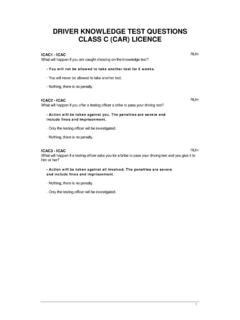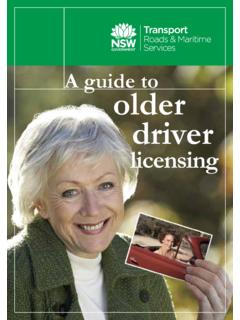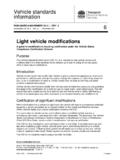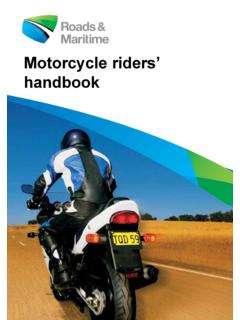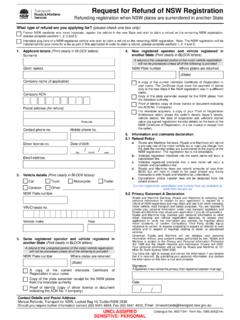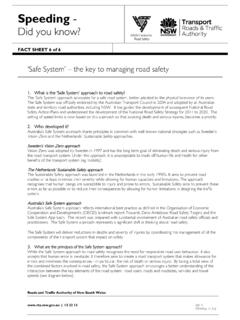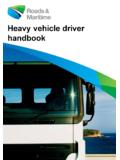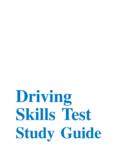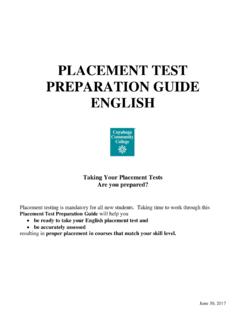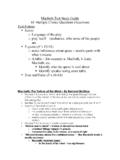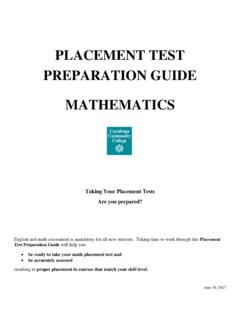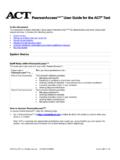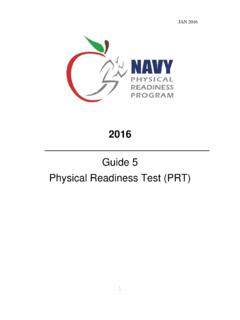Transcription of A Guide to the Driving Test - Roads and Maritime …
1 A Guide to the Driving Test Introduction The Driving test is an important step in gaining your driver licence. When you pass you will be issued with your provisional licence (P1) and will no longer need to keep a log book or have a supervising driver in the car with you. You will be free to continue learning and gaining valuable experience through Driving on your own. This booklet is a general Guide about what is in the Driving test. For more specialised information on the test, the Driving Test (Class C) Testing Officers Manual is available from Roads and Maritime Services ( Roads and Maritime ) website This booklet is not a book of road rules. For information on road rules refer to the Road Users' Handbook or the Road Rules 2008, they are also available for free from Roads and Maritime website at or the handbook can be purchased for a fee at a registry or a Service NSW centre in your area, the handbook can also ordered by calling the Contact Centre on 13 22 13.
2 A Guide to the Driving Test 1. Contents 1. THE Driving TEST .. 3. The way the test works .. 3. 2. BEFORE YOU START .. 4. Bribing people is against the law .. 4. Booking a test .. 4. A completed logbook .. 4. Taking the test .. 5. Your car must be roadworthy and ready to drive .. 5. Why a test can be cancelled .. 5. 3. LOW RISK Driving .. 6. Observation Scanning .. 6. Checking blind spots .. 7. Speed management Maintain space to the front .. 9. Maintain space when stopped .. 10. Reduce speed.. 11. Road positioning Buffering .. 12. Turns at intersections .. 13. Manoeuvres.. 17. Decision making Affecting the crash avoidance space of others .. 20. Situations with limited vision .. 21. Responding to hazards Hazard and response .. 22. 4. VEHICLE CONTROL .. 26. Operating the controls .. 26. Driving posture .. 27. 5. TEST RESULTS.
3 28. Why you might fail .. 28. Immediate fail .. 32. Test termination .. 33. What happens after the test? .. 35. Test score sheet .. 36. 6. TIPS FOR NEW PROVISIONAL DRIVERS.. 38. Night Driving .. 38. Passenger influences .. 38. Driving distractions .. 38. Licence restrictions for P1 licences .. 39. Licence restrictions for P2 licences .. 40. 2 A Guide to the Driving Test 1. The Driving test This Guide explains what you need to do before taking a test, what you will be tested on, and what happens afterwards. THE WAY THE TEST WORKS. The Driving test follows a set course comprising 25 zones. During the test a testing officer will be in the car with you directing you where to drive, and recording your performance on a score sheet. Your score will be based on your Driving performance in a range of situations and your ability to demonstrate low risk behaviours.
4 You are assessed against five key performance areas: speed management (S); road positioning (P); decision making (D); responding to hazards (H) and vehicle control (C). 1. 2. 3. Some Driving behaviour such as breaking a road rule or following other vehicles too closely is considered to be high risk'. If you behave this way during the test your actions will be recorded as FAIL items and you will not pass, regardless of your score. A detailed explanation of scoring codes is located on the back of the Driving test score sheet. See Section 5 of this Guide for a complete list of fail items. To pass the Driving test you must achieve a score of 90 per cent with no fail items. In all the diagrams in this handbook A. you are always the blue car, marked A. A Guide to the Driving Test 3. 2. Before you start BRIBING PEOPLE IS AGAINST THE LAW.
5 It is illegal to offer, request or accept gifts, rewards, money or other favours in order to get a licence without passing the required tests . Penalties are severe and include fines and imprisonment. All cases of corruption will be investigated and strong action will be taken against all those involved. The only licence fees and charges you have to pay are set by Roads and Maritime . Do not pay any more or offer to pay more to get your licence. If you know or believe that someone has got or is about to get a NSW. licence by offering or responding to a request for a bribe or if you suspect or know of any other corruption involving a Roads and Maritime employee telephone Roads and Maritime on 1800 043 642 (free call) or the Independent Commission Against Corruption (ICAC) on (02) 8281 5999. To avoid misunderstanding make sure all money and valuables in your vehicle are locked away or out of sight.
6 BOOKING A TEST. When you are ready to take the Driving test, you need to make a booking by either: Going online to Roads and Maritime Online Services at Calling Roads and Maritime on 13 22 13. Or in person at a registry, agency or a Service NSW centre in your area. Bookings made by phone or online can be paid for by credit card only. Bookings made at registry, agency or a Service NSW centre can be paid by eftpos, cash, cheque or credit card. Should you wish to change or cancel your booking, you may do so. This must be done at least 24 hours prior to the test date or your fee will not be refunded. A COMPLETED LOGBOOK. Before you can take a Driving test you must have: The required amount of Driving experience recorded in your Learner Driver Log Book. The Declaration of Completion' signed by your supervising driver in your Learner Driver Log Book.
7 4 A Guide to the Driving Test 2. TAKING THE TEST. When you go to the testing centre for the Driving test, you must have a person with you who has a full driver licence. If you fail the test you cannot drive away on your own and will need a licensed driver to be with you. Plan to arrive at the testing centre in good time for your appointment. Give your Learner Driver Log Book and booking confirmation slip to the person at the counter. You will be referred to a testing officer. The testing officer will ask you to sign the score sheet. Remember to ask any questions before you start. The testing officer cannot tell you how to drive or coach you during the test as it is an assessment of your ability to drive on your own. A monitoring officer may sit in on your test. The monitoring officer's job is to watch the testing officer and make sure that the test is conducted properly.
8 Nobody other than the testing officer and monitoring officer is allowed to be in the vehicle with you during the test. Try to relax. You will not be expected to drive as skilfully as an experienced driver. Remember, you can try again if you fail. However, you must wait a minimum of seven days before you may reattempt the Driving Test. After the test, the testing officer will review your performance if you wish. Testing officers will provide general comments rather than discuss specific situations or events. If you fail you will receive a Driving test record that shows the areas where you need to improve. YOUR CAR MUST BE SUITABLE FOR SAFE USE AND READY. TO DRIVE. Before the test starts the testing officer will check to make sure that your car is suitable for safe use. See the checklist in Section 5 Test results. WHY A TEST CAN BE CANCELLED.
9 If there is any suspicion that you have recently taken alcohol or another drug, the test will be cancelled and there will be no refund of the test booking fee. If you offer money, some other bribe, or try to influence the testing officer, the test will be stopped and you may be taken to a police station and charged with offering a bribe. A Guide to the Driving Test 5. 3. Low risk Driving Driving is never risk free, but you should aim to drive low risk'. You will be assessed on your low risk Driving skills in speed management, road positioning and decision making. The test also assesses your ability to perceive and respond to hazards. Observation Observation is an essential skill for a low risk driver. The testing officer will be assessing your observation techniques throughout the test. You will fail if your observation is poor.
10 SCANNING. Scanning is keeping your eyes moving, checking in one area for no more than a couple of seconds and then moving your eyes to another area. Low risk drivers constantly scan traffic conditions. When Driving around corners turn your head and look through the corner scanning the road ahead of your vehicle. Slow down if vision of the road ahead is limited. You will be expected to make regular checks in your rear vision mirror so you know what is happening behind you. You must check your rear vision mirror before you slow down or change direction. When scanning look: In the distance. At the road surface. To the left and right. In your mirrors. At the instruments and gauges. Before proceeding through traffic lights, you must turn your head and check to ensure there are no vehicles that may be running' the red light, or pedestrians crossing against the don't walk' sign.
